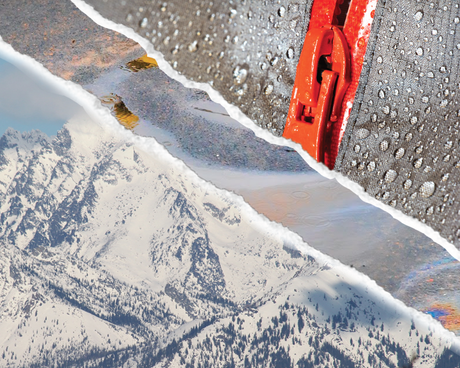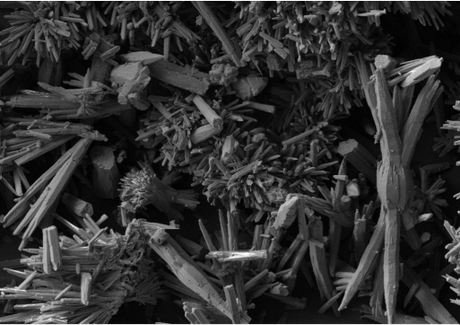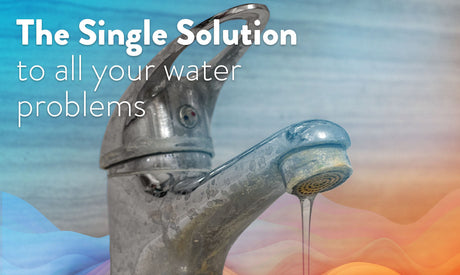Better Living Through Chemistry?
The 1950s were an amazing time. People were enjoying peace, wealth, and a sense of optimism. The war was over, prosperity was rising, and for many families, life felt simple. Living in the moment. The “nuclear family” was the ideal, and chemistry—powered by wartime innovation—promised to support that perfect life.
Chemists were making miracles. Driven by the belief that we could engineer the world to our will, they developed new compounds with extraordinary properties. Chief among them was a class of chemicals built around a bond so strong it was nearly unbreakable: the carbon-fluoride bond.
These synthetic chemicals resisted water, oils, fats, and waxes. They didn’t want to interact with anything—didn’t want to share electrons. And that made them incredibly useful.
Soon, they were marketed as modern miracles, and they showed up in nearly every home:
- Non-stick cookware
- Water-repellent clothing
- Stain-resistant upholstery
- Fire-retardant mattresses
- Rust-preventative coatings
- Long-lasting lubricants
This wasn’t just one compound. The carbon-fluoride bond forms the backbone of a whole family of chemicals, each tailored for its application. Today, we know them as PFAS—per- and polyfluoroalkyl substances. And they really do work. PFAS have made life more convenient, safer in some ways, and more durable.
But the same properties that made PFAS useful are what now make them troubling.
These compounds don’t exist in nature. Nothing in the natural world evolved to break them down. That’s why they persist—in water, in soil, in living things. Once they’re in the environment, they stay there. They accumulate. They concentrate in animals (including humans), disrupting bodily systems that were never meant to handle them. Our kidneys and livers can’t do much to move them along.
So, who’s to blame? That’s still up for debate.
Some say the chemists of the 1950s didn’t know better. Others believe the risks were known—and buried under fine print and lobbying. Labels like “Use only as directed” might protect companies legally, but they don’t reflect how people actually use products. Take a look at almost any non-stick pan in a home. There’s almost always a scratch. That scratch is breakdown. That’s PFAS going into food.
The Cost of Avoidance
Here’s the uncomfortable truth: if you really wanted to avoid PFAS, you’d have to give up nearly every modern convenience.
- Forget the non-stick pans—cast iron only.
- Skip the take-out box—your food came in a PFAS-lined container.
- Your waterproof hiking jacket? Treated.
- The stain-resistant couch you just financed? Soaked.
- Your car seats? Fire-retardant and likely coated.
- Even your dental floss might be gliding on fluorinated compounds.
To truly opt out of exposure, you’d have to trade performance for natural materials. Glass, ceramic, untreated cotton, wool, wood. You’d have to know your supply chains. You’d live with more stains, more rust, more friction, and more fires that spread faster. You’d have to accept less convenience.
And even then—your exposure wouldn’t be zero. Because it’s in the dust. The water. The blood of the species around us.
That’s not to say all is lost. But it is to say: be wary of anyone offering a silver bullet. This isn’t a problem we can buy our way out of with a single filter.
Why We Don’t Sell PFAS Filters
We’re often asked if we offer a filter for PFAS. The short answer is: we don’t. And we think it’s important to explain why.
The EPA is actively developing nationwide standards for PFAS. As part of that, all public water systems are now required to test for these chemicals and treat them where levels are high. That means in most areas, the water coming out of the tap will already be treated by the utility.
If we sold a PFAS filter, it would likely be redundant for the vast majority of people. And we don’t feel good about selling a product that may not actually solve a problem for most customers.
PFAS filters—real ones, not marketing gimmicks—also require careful handling. They don’t destroy the chemicals; they just trap them. That means at some point, someone has to figure out how to dispose of the spent filter without putting the chemicals right back into the environment. And that someone is the homeowner.
There’s no clear or easy path for safe disposal. You’d likely need to contact your local government to ask about hazardous waste protocols—and hope your community has access to commercial destruction services. Most people won’t know to do that, and if a PFAS-laden filter ends up in a regular landfill, nothing is truly solved.
That doesn’t sit right with us.
At Cascadian, we focus on water treatment solutions that clearly improve lives. Products that solve real problems—hardness, chlorine, sediment, iron, bacteria. Filters that are simple to understand, easy to maintain, and that actually bring joy back to water.
Pure and simple.










1 comment
While I appreciate that you took the time out to write your response as to why you choose not to filter out PFAS, quite honestly much of your argument consists of red herrings. Most people who are concerned about PFAS in their water supply are already aware that these chemicals are found in many different sources such as those you mention, and are already attempting to limit their exposures. Most people are very aware that there is at present no way to eliminate these exposures entirely. People can and do choose to cook in stainless steel, enamel and other materials that do not contain PFAS. People can and do take steps to use fabrics in clothing and bedding that do not contain PFAS. Etcetera. The point being that we can take meaningful steps to limit our exposure to external sources of these chemical contaminants, while aware we can’t eliminate them entirely.
But water is the most concerning source because there is no alternative to water. And we have no easy or inexpensive way to determine to what degree our water is contaminated with these dangerous and invisible chemicals. We have to drink and bathe in water that may well be contaminated. Most of us just don’t know because the information about any specific water supply is very hard to come by. For example, I live in Coupeville, WA. Coupeville’s water was highly contaminated with PFAS until the town had to replace its water filtration system about four years ago. But the water reports I have seen don’t even include PFAS test results and trying to get specific information from anyone is like trying to squeeze water out of a rock. Do I trust that our government has taken care of the problem? No, I don’t, especially when anyone you try to get information from pleads ignorance. I’d feel a lot better if I could control my water quality myself, in my own house.
So, yes, I would very much like to have a water filtration system in my house that filters out PFAS so I can stop worrying about that particular source. I currently have your filters, plus I have a ZeroWater countertop filtration unit for drinking water in the kitchen. ZeroWater is certified to filter out 99% of PFAS. But it’s a hassle and takes up space and I’d rather have this filtration built into the whole house system. I’d rather not have any PFAS in my shower and laundry.
You are incorrect in saying that US regulations insure that most household water is PFAS free. This study found PFAS contamination in 45% of U.S. household drinking water supplies, both from wells and public water systems: https://www.sciencedirect.com/science/article/pii/S0160412023003069?via%3Dihub. Here in western Washington contamination has been found everywhere, in more and more locations. It would be great if there was a filtration company that would address this problem with a whole house system that filtered out PFAS along with the other usual contaminants. I think a company that could do that would be very successful and provide a valuable service. There’s an opportunity there, and you know it since you say so many people are asking for it.
By the way, the more testing is done, the more exposure is found. PFAS contamination in the U.S. (March 2025): https://www.ewg.org/.interactive-maps/pfas_contamination/. Yes, there are new regulations, but they are slow to be implemented, and most sites will take years, if ever, to resolve. Equally concerning, as these compounds are studied, the level of exposure correlated with bad health outcomes keeps dropping. It’s a bad situation. Like many, I want more control over my own health, even if limited. My two cents.
Best regards from a customer,
Andrea Rudenko